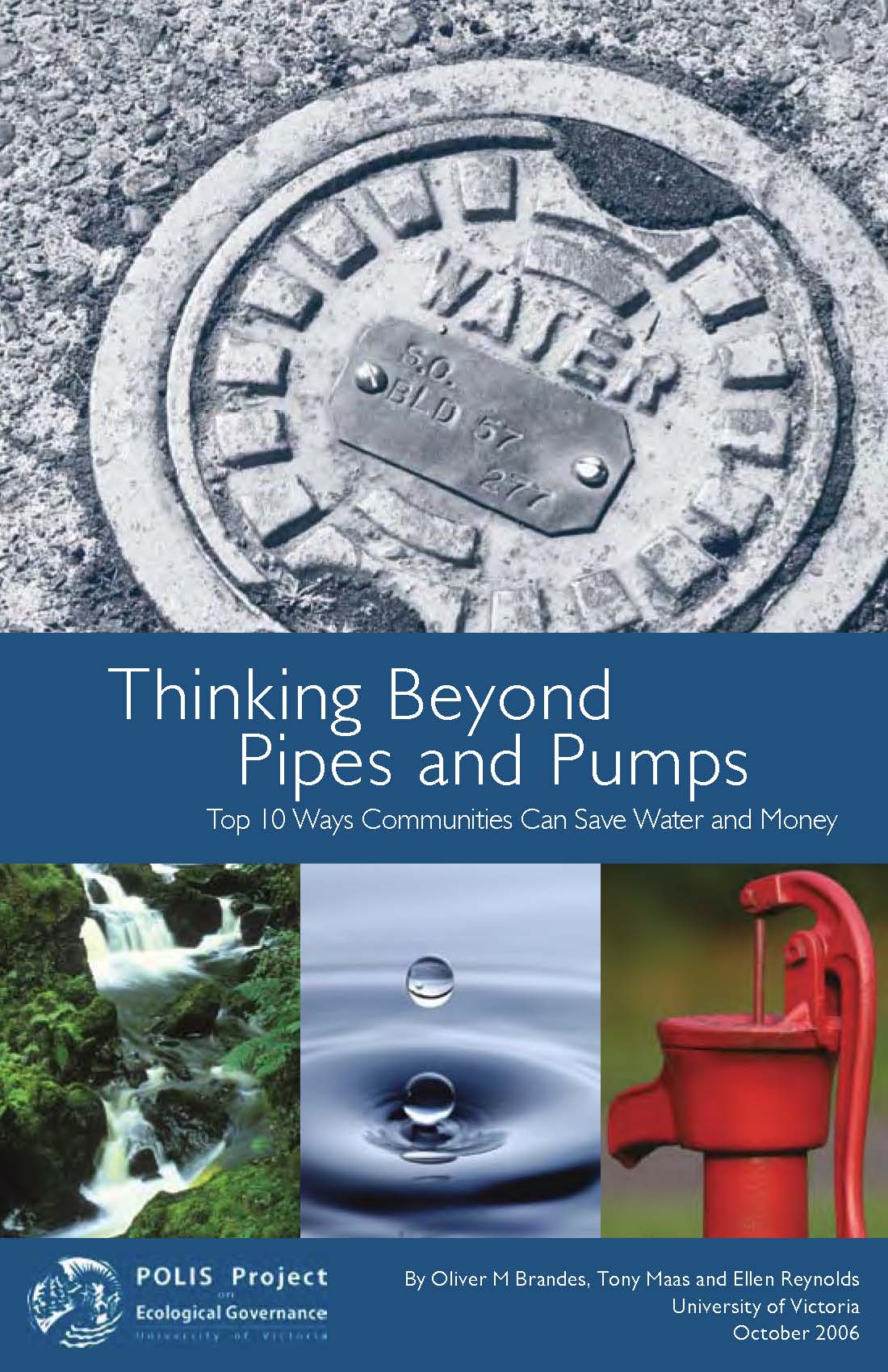PUBLICATION: Thinking Beyond Pipes and Pumps: Top 10 Ways Communities Can Save Water and Money
Context
Each year, more Canadian communities face the one-two punch of scarce water supplies and growing water demands. Some have eked out the dry months with lawn watering restrictions. Others, like Tofino, BC on Canada’s “wet coast” found themselves begging businesses to shut down to save dwindling water supplies. And in Ontario, Waterloo Region plans to plumb the Grand River valley with a pipeline to Lake Erie.
A new report from Water Sustainability Project at the University of Victoria’s POLIS Project on Ecological Governance offers an alternative approach. Thinking Beyond Pipes and Pumps: Top 10 Ways Communities Can Save Water and Money is a practical guide that urges community leaders and water managers across Canada to look to water conservation and efficiency as the basis for a new urban water infrastructure.
 “Too often, communities respond to 21st century water problems with 20th century solutions— bigger pipes and bigger pumps leading to bigger tax bills” says Michael M’Gonigle, Eco- Research Chair of Law and Policy at the University of Victoria. “Communities are missing out the full potential of water conservation and efficiency.”
“Too often, communities respond to 21st century water problems with 20th century solutions— bigger pipes and bigger pumps leading to bigger tax bills” says Michael M’Gonigle, Eco- Research Chair of Law and Policy at the University of Victoria. “Communities are missing out the full potential of water conservation and efficiency.”
Based on three years of research, Thinking Beyond Pipes and Pumps makes the case for water conservation as the best “new” source of water for urban areas.
 “Water conservation programs are growing in most large Canadian urban centres, but we have barely made a dent in what’s possible,” says Glen Pleasance, Chair of the Canadian Water and Wastewater Association’s Water Efficiency Network. “The potential is huge, and this report provides clear direction on how to capitalize on it.”
“Water conservation programs are growing in most large Canadian urban centres, but we have barely made a dent in what’s possible,” says Glen Pleasance, Chair of the Canadian Water and Wastewater Association’s Water Efficiency Network. “The potential is huge, and this report provides clear direction on how to capitalize on it.”
 The report’s authors stress that conservation is about more than installing low-flow toilets. “We need to reconsider what we call urban water infrastructure,” says Oliver M. Brandes, Water Sustainability Project leader and senior research associate at POLIS. “In addition to our current water supply systems, we need to include decentralized technologies and local programs directed at changing behaviour.”
The report’s authors stress that conservation is about more than installing low-flow toilets. “We need to reconsider what we call urban water infrastructure,” says Oliver M. Brandes, Water Sustainability Project leader and senior research associate at POLIS. “In addition to our current water supply systems, we need to include decentralized technologies and local programs directed at changing behaviour.”
 Tony Maas, co-author of the report adds, “By developing programs that integrate new technologies, pricing and education, communities can delay or eliminate the need for costly and ecologically disruptive infrastructure expansion.”
Tony Maas, co-author of the report adds, “By developing programs that integrate new technologies, pricing and education, communities can delay or eliminate the need for costly and ecologically disruptive infrastructure expansion.”
To Learn More:
Download a copy of Thinking Beyond Pipes and Pumps: Top 10 Ways Communities Can Save Water and Money
About the Project
The Water Sustainability Project (WSP) is an initiative that began in January of 2003 at the POLIS Project on Ecological Governance at the University of Victoria. The WSP team seeks to understand the structure and dynamics of urban water use, and to provide mechanisms to help reorient Canadian water management from supply to demand-side approaches. Formerly the Urban Water Demand Management Project (UWDM), the initiative changed its name in 2005 to the Water Sustainability Project to reflect the broader mandate to promote demand management for water as part of the larger goal of sustainable water management.
In the context of “governance for innovation,” a term that promotes the adoption of innovative and alternative solutions, the WSP team has developed a comprehensive legal and policy framework for urban water management and detailed action plans for federal, provincial and municipal governments.
Overall project objectives:
- To examine urban water issues in Canada, including a survey of “best practices” in demand-side management (DSM) both in Canada and abroad;
- To develop water policy decision-making tools that promote model pricing, long-term integrative planning, and regulatory mechanisms to manage urban water demand;
- To create a national network of experts and others interested in DSM to contribute to and use these models as a practical tool for policy and institutional change;
- To increase public awareness around the importance, and limits, of water in Canada, thereby ensuring that the above happens as part of a larger cultural change; and,
- To craft and implement innovative governance options that promote long-term sustainable water management in the 21st Century.


